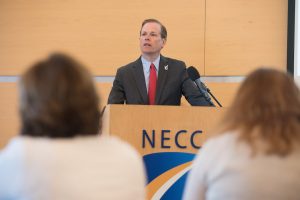Fall Convocation Opens Semester
Community colleges and the future of public higher education in the Commonwealth of Massachusetts were the topic at the Tuesday, Sept.4, Northern Essex Community College fall convocation, when Massachusetts Secretary of Education James A. Peyser visited as guest speaker.
It was standing room only in the Hartleb Tech Center on NECC’s Haverhill campus when President Lane Glenn welcomed faculty and staff back to campus for the fall semester.
After sharing campus updates and introducing new faculty and staff, Glenn introduced Peyser who quickly addressed the state of higher education in the Commonwealth.
Both Glenn and Peyser acknowledged that NECC and all of the state’s education system is “confronted with serious issues” that need to be addressed to maintain and improve educational goals and outcomes.
The role of community colleges is important he noted. “There is no mistake, community colleges transform lives,” said Peyser. “They provide and affordable on-ramp to a four-year degree and they are the indispensable workforce development partners of local employers…”
Despite the fact, that Massachusetts’s K-12 public education system is first in the country, the academic performance of students is “flat”. Although a college degree is a prerequisite for success, he noted, that it is often unattainable because it is unaffordable.
To counter that, the state has launched initiatives such as Commonwealth Commitment, Early College, a deferred maintenance bond bill, and funding for dual enrollment and scholarships.
Declining enrollments are an issue for colleges nationwide. A strong economy, low unemployment and fewer high school graduates despite high graduation rates are all contributing factors.
“This means we need to do a much better job of preparing and supporting students for success…” said Peyser.”…We cannot achieve this goal through business-as-usual or incremental change.”
Peyser outlined five steps to be considered:
Don’t just balance the budget; Change the Model – reconsider the underlying structures and operations and be open to innovations and scalable solutions.
Get focused, grow what works, and stop doing what doesn’t – Develop a clearer understanding of where the institution adds the most value and consentrate resources on being the best in the world in those few vital areas.
Align, coordinate, and integrate to maximize efficiency and value – High Schools and colleges need to work in partnership to create integrated pathways while colleges need to better align their course catalogs to ensure transferable credits.
One size doesn’t fit all; it doesn’t even fit most – Instructional methods, curriculum, materials, and technology tools need to become more flexible and more closely linked with individual student needs. Develop and apply strategies like learning assessments, online competency based education, and stackable micro-credentials.
Put the mission first – Focus on the larger mission, which is to create opportunity for all to achieve success for themselves and their families, in service to their communities, the Commonwealth, and our country.
- Nate Gilbert and Ari Chicklis announce the new Name the Knight Contest.
- Jeff Bickford warns of “phishing attacks”.
- Karen Hruska announces the return of Free Farmers Market the 4th Tuesday of every month and the launch of Food for Free for NECC students as well as PB & J popup sandwich stations.











